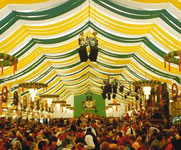
Saltwater made Lüneburg into a rich town and the queen of the Hanseatic League. The magnificent façades on its merchants' town houses hark back to that time. Of course salt has a very welcome side effect in that it makes people thirsty, and as a result medieval Lüneburg had one of the highest concentrations of breweries of the time. In its heyday in the Middle Ages, the salt works provided employment for about 500 people. It was the town's largest industrial operation and was only closed in 1980 after more than a thousand years of salt production. If there had been such a thing as nature conservation in the Middle Ages, the Lüneburg Heath would not be here today, because this much celebrated, much admired jewel of the German countryside that attracts hundreds of thousands of visitors when the heather is in full bloom in August and September only came into being because of a crime against nature. Once it was covered in lush woodland.

But because people needed wood for the medieval salt works to boil the saltwater, to purify the salt, make it edible and finally saleable, over time all the trees were felled. Pretty heather plants were then able to spread over the bare soil and sheep kept the grass short. A trip along the Salt Road promises a rich blend of nature and culture; whether you go by bike, on foot or part of the way by paddle steamer. This is a journey through past and present that tells the story of salt: where it came from, what it was used for and how it was transported.




